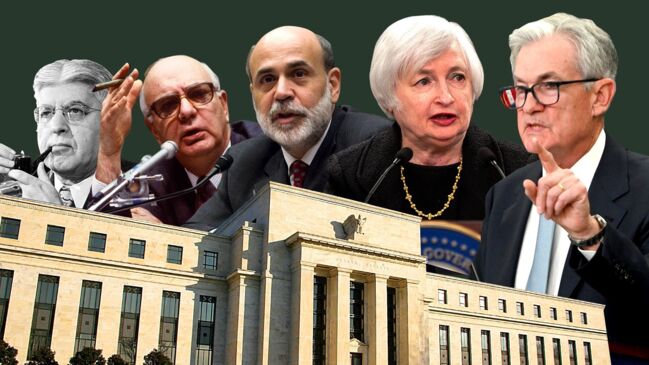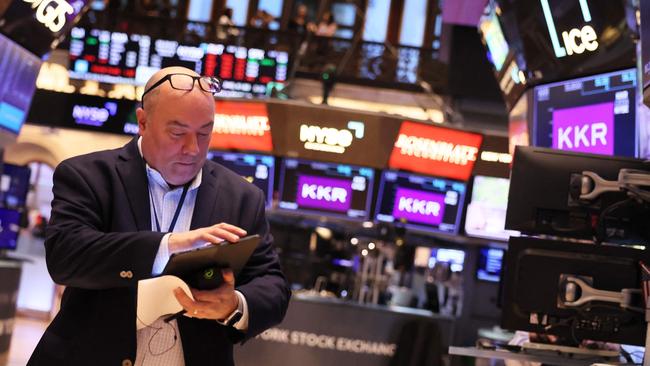Powell: US can ‘be a little patient’ after rates hit 22-year high
Fed Reserve chair Jerome Powell’s 25 basis points rise to a range of 5.25-5.5 per cent comes as he sees a path to a soft landing and leaves the September decision in play.

The US Federal Reserve resumed lifting interest rates overnight with a quarter-percentage-point increase that will bring them to a 22-year high.
The unanimous decision to raise the benchmark federal-funds rate to a range between 5.25 per cent and 5.5 per cent ended a brief pause in rate increases last month as officials debate whether they have done enough to combat inflation.
It is the 11th increase since March 2022, when they lifted rates from near zero.
The Fed made minimal changes to its postmeeting statement, offering no new guidance about its future policy plans.
At a news conference after the meeting, Fed Chair Jerome Powell didn’t rule out another rate rise at the central bank’s next meeting, but he emphasised how much the central bank had already done and the amount of time it can take for monetary policy to cool inflation.
“We can afford to be a little patient, as well as resolute, as we let this unfold,” he said. “We think we’re going to need to hold, certainly, policy at restrictive levels for some time, and we’d be prepared to raise further if we think that’s appropriate.”
Markets were mixed after the Fed decision.
Economic growth has likely been too firm for Powell to signal that this increase will be the last of the current tightening cycle, as many investors anticipate. At the same time, a recent slowdown in inflation could take pressure off the need for central-bank officials to keep raising rates.
He stressed there’s still “a long way to go” in terms of getting inflation down to 2 per cent and doesn’t see that until around 2025. Powell also said he doesn’t think the central bank will cut rates this year.
At their previous meeting in June, officials held rates steady but pencilled in two more increases this year. Fed officials are scheduled to meet three more times this year, with the next meeting in September.

Inflation has retreated from a 40-year high hit last summer, with the consumer-price index climbing 3 per cent in June from a year earlier – well below the June 2022 peak of 9.1 per cent.
Fed officials have been concerned that underlying price pressures may prove more persistent as a tight labour market allows workers to bargain for higher pay, making it harder to get inflation down further.
Core prices, which exclude volatile food and energy categories, posted the smallest monthly gain in more than two years in the June CPI. Still, the core CPI rose 4.8 per cent in June from a year earlier. Until last year, the core CPI hadn’t registered such increases since the early 1990s.
Fed officials are focused on core inflation because they see it as a better predictor of future inflation than the overall inflation rate.
The Fed seeks to keep inflation at 2 per cent over time, as measured by its preferred gauge, the personal-consumption expenditures price index. The Fed fights inflation by slowing the economy through raising rates, which causes tighter financial conditions such as higher borrowing costs, lower stock prices and a stronger dollar.
The Fed boosted interest rates aggressively in 2022 and then slowed the pace at the end of the year. Holding rates steady in June offered a way to further dial down the pace of increases and study the effects of those rapid moves, particularly after fears that banking stress this spring might further constrain credit, Powell said last month.
Officials had signalled disagreement in recent months over how quickly to keep raising rates. While all 11 voting members of the policy-setting Federal Open Market Committee agreed to last month’s decision to hold rates steady, some of the 18 voting and non-voting officials would have supported a rate rise at the June meeting, according to a written account of the meeting released earlier this month.

Fed officials meet eight times a year, or roughly twice each quarter. While Powell said last month he wouldn’t rule out raising rates at consecutive policy meetings, he said moving rates up at a slower, quarterly pace could be expected to continue if the economy evolves in line with current expectations.
A handful of Fed officials, however, have suggested they might prefer to raise rates again at the central bank’s September meeting.
Fed officials in June raised their projections for interest rates in part because they anticipated less progress on inflation. If inflation continues to cool, that development would raise questions over whether another rate rise later this year will be needed.
Energy and commodity prices have been responsible for much of the decline in inflation over the past year. A recent upturn in some of those prices could underscore why officials will want to be cautious about assuming further declines in inflation, said Eric Rosengren, who served as Boston Fed president from 2007 to 2021.
A slowdown in core inflation over the coming months could create a new conundrum for the Fed if officials see reasons to think the improvement will be short lived — for example, because wage growth stays firm.
“This is the old, ‘Be careful what you wish for,’” said Richard Clarida, who served as Powell’s second-in-command from 2018 until January 2022.
Economists have debated over the past year whether slowing labour demand will require joblessness to rise or whether that can happen as companies reduce vacancies but not head count.
“A lot of the debate on the labour market is beside the point,” Clarida said. “If I was still over there, what I would worry about is the following: If we don’t get a deceleration in wages and we don’t get a pick-up in productivity, then we’re not going to hit our inflation target.”





To join the conversation, please log in. Don't have an account? Register
Join the conversation, you are commenting as Logout